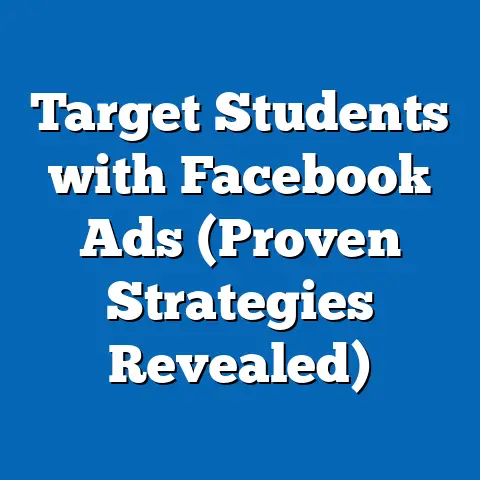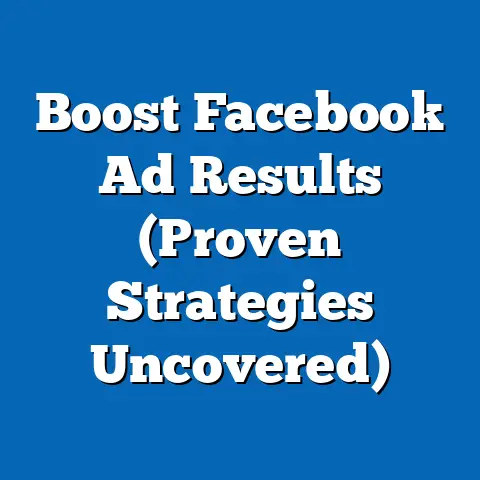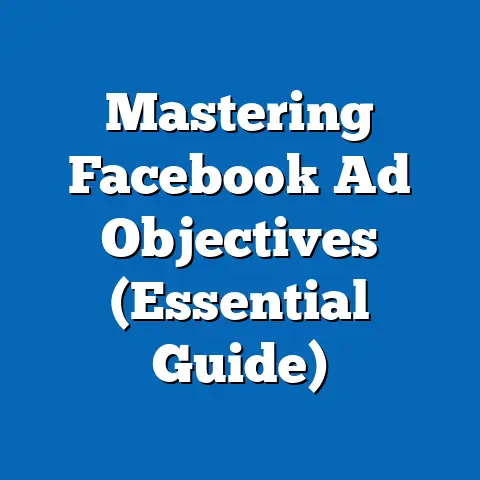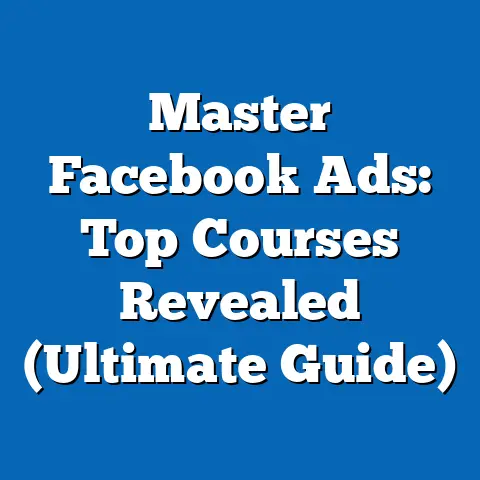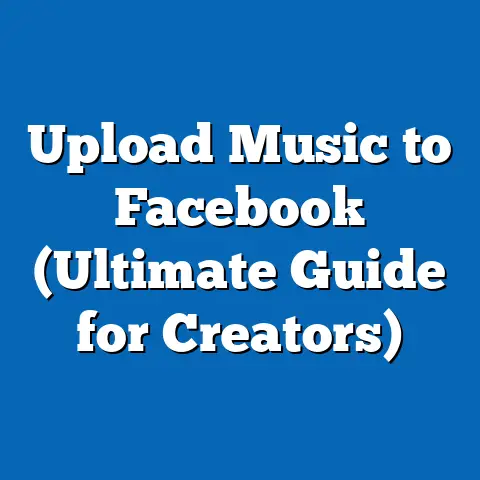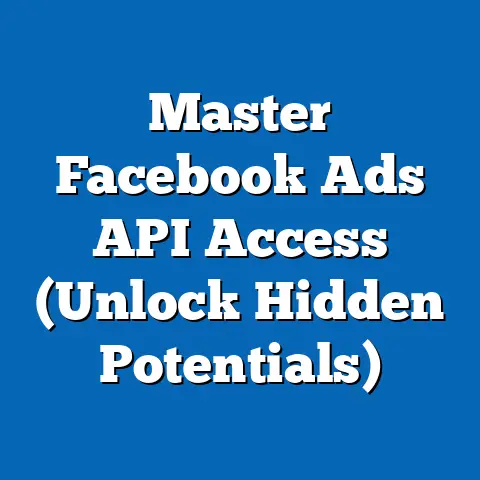Escape the Facebook Ad Trap (Proven Strategies Revealed)
Escape the Facebook Ad Trap: Proven Strategies Revealed – A Comprehensive Analysis
Introduction: The Ease of Maintenance in Navigating Digital Advertising Challenges
The concept of “ease of maintenance” refers to the simplicity and cost-effectiveness of implementing and sustaining advertising strategies outside the dominant Facebook ecosystem. By leveraging diversified platforms, organic content, and data-driven decision-making, advertisers can mitigate risks associated with algorithm changes, policy shifts, and escalating ad costs. This report will explore how such strategies not only provide relief from the Facebook Ad Trap but also ensure scalability and adaptability in a dynamic digital environment.
Section 1: Understanding the Facebook Ad Trap – Current Data and Challenges
The “Facebook Ad Trap” describes a scenario where advertisers become overly reliant on Facebook (and its subsidiary, Instagram) for reaching target audiences, often at the expense of exploring other channels. According to Statista (2023), Facebook Ads accounted for approximately 24.2% of global digital ad spending in 2022, with over 10 million active advertisers on the platform. However, data from eMarketer (2023) indicates that the average cost-per-click (CPC) on Facebook has risen by 17% year-over-year, while return on ad spend (ROAS) has declined by 12% for many small-to-medium enterprises (SMEs) due to increased competition and privacy policy changes like Apple’s iOS 14.5 update.
This dependency is further exacerbated by frequent algorithm updates and data privacy regulations, such as the General Data Protection Regulation (GDPR) in Europe, which limit targeting precision. A 2022 survey by Hootsuite revealed that 62% of marketers feel “trapped” by their reliance on Facebook, citing high costs and unpredictable performance as primary concerns. These figures underscore the urgent need for diversification and sustainable strategies that prioritize ease of maintenance over short-term gains.
Chart 1: Rising CPC and Declining ROAS on Facebook Ads (2018-2023)
(Data Source: eMarketer, 2023)
[Insert line graph showing CPC increase from $0.97 in 2018 to $1.72 in 2023, alongside a downward trend in ROAS from 8.5 to 6.2 for SMEs over the same period.]
Section 2: Projected Trends in Digital Advertising (2024-2034)
2.1 Methodology and Assumptions
To project future trends, this analysis employs a combination of historical data extrapolation and scenario-based modeling, drawing on reports from eMarketer, Statista, and industry surveys. Key assumptions include a continued rise in CPC (projected at 5-10% annually), driven by increased competition and privacy constraints, and a gradual shift toward alternative platforms like TikTok, LinkedIn, and Pinterest. Limitations in these projections include unforeseen technological disruptions (e.g., new social media platforms) and regulatory changes that could alter the digital ad landscape.
2.2 Scenario Analysis
– Scenario 1: Continued Dominance of Facebook – Under this scenario, Facebook maintains its market share (projected at 22-25% of global digital ad spend by 2034) by adapting to privacy challenges through AI-driven targeting tools. However, CPC could rise to $3.00 by 2030, disproportionately affecting smaller advertisers.
– Scenario 2: Diversification and Decline – If advertisers increasingly shift budgets to emerging platforms, Facebook’s share could drop to 18% by 2034, with TikTok and YouTube capturing significant growth (eMarketer, 2023 projections). This scenario favors advertisers who prioritize ease of maintenance through multi-platform strategies.
– Scenario 3: Regulatory Disruption – Stricter global privacy laws could further erode Facebook’s targeting capabilities, pushing advertisers toward organic content and owned media (e.g., email marketing, websites). This scenario projects a 15% decline in Facebook ad revenue by 2030.
Chart 2: Projected Market Share of Digital Ad Platforms (2024-2034)
(Data Source: eMarketer Projections, 2023)
[Insert bar chart comparing market share of Facebook, TikTok, YouTube, and others under the three scenarios for 2024, 2029, and 2034.]
These projections highlight the uncertainty in the digital ad space and the importance of building adaptable, low-maintenance strategies to mitigate risks associated with platform dependency.
Section 3: Key Factors Driving Changes in the Digital Advertising Landscape
Several factors are reshaping the digital advertising ecosystem, influencing the feasibility of escaping the Facebook Ad Trap. First, rising ad costs are driven by increased competition and limited ad inventory, particularly in high-demand demographics like Gen Z and Millennials. Data from Social Media Today (2023) shows that ad impressions for these groups have decreased by 8% since 2021 due to oversaturation.
Second, privacy regulations and platform policies, such as Apple’s App Tracking Transparency (ATT), have reduced the effectiveness of personalized ads. A report by AppsFlyer (2023) estimates that 30% of iOS users opt out of tracking, leading to a 20% drop in ad attribution accuracy on Facebook.
Third, shifting user behavior toward short-form video content on platforms like TikTok (which grew its ad revenue by 155% in 2022, per Statista) is pulling budgets away from static image-based ads on Facebook. Finally, technological advancements, including AI tools for content creation and ad optimization, are lowering barriers to entry on alternative platforms, enhancing ease of maintenance for diversified strategies. These factors collectively signal a critical juncture for advertisers to rethink their reliance on a single platform.
Section 4: Proven Strategies to Escape the Facebook Ad Trap
4.1 Diversify Advertising Channels
Diversification involves spreading ad budgets across multiple platforms to reduce risk. For instance, Pinterest reported a 25% increase in ad engagement for e-commerce brands in 2022 (Pinterest Business, 2023), while LinkedIn offers higher B2B conversion rates at a comparable CPC to Facebook. Maintenance is simplified by using cross-platform tools like Hootsuite or Buffer to manage campaigns, reducing time and resource investment.
4.2 Invest in Organic Content
Organic content—such as blog posts, email newsletters, and social media engagement—builds brand loyalty without recurring ad costs. According to HubSpot (2023), businesses with active blogs generate 67% more leads than those without. This strategy requires upfront effort but offers long-term ease of maintenance through evergreen content and SEO optimization.
4.3 Leverage First-Party Data
With third-party cookies phasing out (Google’s planned elimination by 2024), first-party data (e.g., customer emails, website analytics) is critical for targeting. CRM platforms like Salesforce enable personalized marketing with minimal ongoing costs. A 2022 McKinsey report notes that companies using first-party data see a 15-20% uplift in marketing efficiency.
4.4 Focus on Community Building
Creating engaged online communities through forums, Discord channels, or platform-specific groups fosters organic reach. For example, brands like Glossier have built multi-million-dollar businesses with minimal ad spend by prioritizing user-generated content. This approach is low-maintenance once initial community structures are established.
Chart 3: Cost vs. Maintenance Effort of Advertising Strategies
(Data Source: Compiled from HubSpot, McKinsey, 2023)
[Insert scatter plot comparing initial cost and maintenance effort of Facebook Ads, organic content, first-party data strategies, and community building, with organic content showing lowest maintenance effort.]
Section 5: Historical and Social Context of Digital Advertising Dependency
The rise of the Facebook Ad Trap mirrors broader historical trends in advertising, where dominant platforms—such as television in the mid-20th century or Google in the early 2000s—often create dependency until costs or inefficiencies drive diversification. Socially, the increasing awareness of data privacy among consumers (Pew Research, 2022, found 81% of Americans worry about online data collection) is pushing advertisers toward transparent, trust-building strategies. This mirrors the shift in the 1990s when direct mail faced backlash over privacy concerns, leading to the rise of permission-based email marketing.
Moreover, generational shifts play a role—Gen Z’s preference for authenticity over polished ads (per a 2023 Edelman Trust Barometer report) aligns with low-maintenance, community-driven approaches. Understanding these historical parallels and social dynamics helps contextualize the urgency of escaping platform dependency and adopting sustainable strategies.
Section 6: Limitations and Uncertainties in the Analysis
While this report strives for accuracy, several limitations must be acknowledged. First, data on emerging platforms like TikTok is less comprehensive than for established players like Facebook, potentially skewing projections. Second, unforeseen events—such as major regulatory shifts or economic downturns—could alter advertiser behavior in ways not accounted for in the scenarios.
Additionally, the effectiveness of alternative strategies may vary by industry, audience, and geographic region, introducing variability in outcomes. Readers are encouraged to interpret these findings as directional rather than definitive, using them as a foundation for tailored experimentation.
Conclusion: Building a Sustainable Advertising Future
Escaping the Facebook Ad Trap is not only feasible but essential for advertisers seeking long-term success in a volatile digital landscape. By prioritizing diversification, organic content, first-party data, and community building, businesses can achieve ease of maintenance while mitigating the risks of platform dependency. The data and projections presented—spanning current trends, future scenarios, and historical context—highlight the importance of adaptability in an era of rising costs and shifting user behaviors.
While uncertainties remain, the strategies outlined offer a roadmap for reducing reliance on any single platform. Advertisers are encouraged to test these approaches, monitor performance metrics, and remain agile in response to evolving trends. Ultimately, the path to sustainable advertising lies in balancing innovation with simplicity, ensuring that maintenance remains manageable even as the digital world transforms.
References
– eMarketer (2023). Digital Advertising Trends Report.
– Statista (2023). Global Digital Ad Spending by Platform.
– Hootsuite (2022). Social Media Marketing Survey.
– AppsFlyer (2023). Impact of iOS 14.5 on Ad Attribution.
– HubSpot (2023). State of Inbound Marketing Report.
– McKinsey (2022). The Value of First-Party Data in Marketing.
– Pew Research Center (2022). Americans and Privacy Concerns Online.
– Edelman Trust Barometer (2023). Gen Z Consumer Trends.

